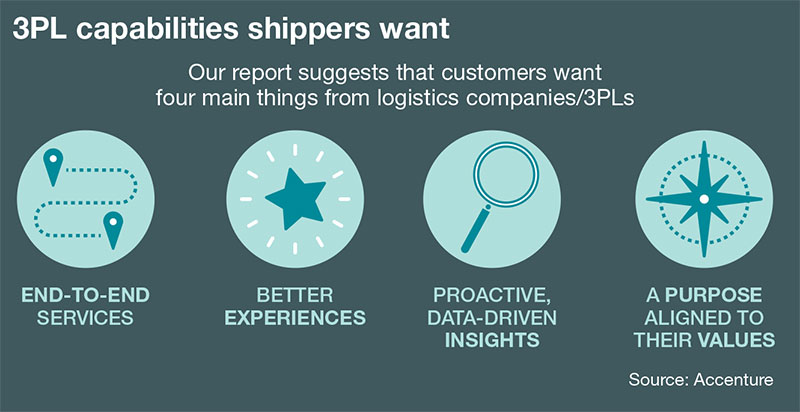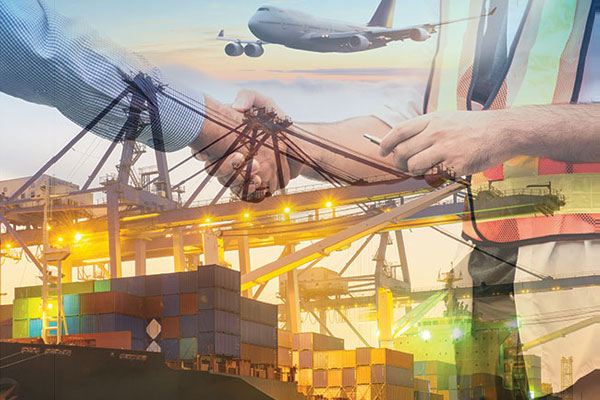Time for Shippers and 3PLs to Innovate Together
A strong collaboration between 3PLs and shippers can help to bring innovative solutions that will benefit both in the future. To do so, shippers must express their needs and challenges, and 3PLs must listen and find paths to address and adapt—and both must recognize the value of these partnerships.
Disruption from the COVID-19 pandemic continues to affect the supply chain, putting stress on shippers. In fact, a recent Accenture survey of C-level executives shows that the impact of supply chain disruption could linger for up to three years, and business leaders across the globe are rethinking supply chain networks. Getting it right will require shippers and third-party logistics (3PL) providers to employ new ways of thinking in order to successfully partner and innovate.
There are multiple converging factors making it challenging to navigate the current supply chain complexities. Capacity constraints in sea and air services coupled with bottlenecks at ports and distribution centers (DCs) has led to unprecedented pricing for transportation, increases in disruption-related fees and general inflationary pressures—all of which make it very difficult to control costs.
As a result, shippers are working to ensure the right inventory is close to order destinations to capture next-day and same-day delivery demands and reduce shipping needs. Labor shortages, particularly in core supply chain jobs such as pick and pack, trucking, and entry-level administration are putting additional stress on shippers.
On top of it all, companies are facing rising demand across all stakeholders—from customers and investors to employees and consumers—for logistics models that lower carbon emissions. Industry commitments to sustainability are getting stronger, but the paths to get there are not always clear and straightforward.

What shippers want
This paints the picture of a dire situation, but all hope is not lost. This moment in time presents a major opportunity for shippers to reinvent their supply chains. Key to this transformation will be the way they work with 3PLs—and for 3PLs to understand more deeply the needs of the shippers.
Our research shows that there are four capabilities shippers want from logistics companies.
They are as follows:
- End-to-end services. Shippers are looking for a one-stop-shop for all logistics services. This means that, beyond basic logistics, they want a trusted logistics provider that delivers new services such as advisory and supply chain consulting services, analytics capabilities, e-commerce channel management capabilities, and even algorithms that match demand and supply.
- Better experiences. Shippers want a logistics partner that knows their business and will work with them to overcome challenges by bringing in customer-centric solutions. Our research revealed the need for 3PLs to build service consistency, flexibility and responsiveness to create more satisfying customer experiences.
- Proactive, data-driven insights. Shippers are eager to partner with 3PLs that have data and analytics capabilities to provide visibility and insights to help them make better supply chain decisions. For example, digital twin capabilities that tap into data to simulate supply chain impacts will help 3PLs guide shippers in decisions with more certainty.
- Purpose aligned to their values. Increasingly, shippers are choosing to work with businesses that are more integrated with theirs and share their values. For example, in the logistics space sustainability is a key issue and becoming a “must-have” requirement for all players.
Third-party logistics providers will need to focus on these capabilities to stay relevant. Our research shows that logistics providers are already prioritizing service expansion to cater to changing shipper needs. In fact, 48% of logistics providers are following vertical integration strategies (integrating upstream or downstream services), and 35% are pursuing horizontal integration strategies (expanding offerings in the current domain and doubling down on the service areas that offer the greatest competitive advantage).
3PLs reaching out
Historically, shippers have relied on 3PLs to cost-effectively manage asset-based activities such as transportation and warehousing; however, those relationships have expanded over the past few years, as 3PLs now offer critical, real-time visibility and reporting. Further evolution and extension of 3PL services and capabilities can help shippers address the supply chain complexities.
Examples are as follows:
New ways of working. Shippers can gain access to talent and build new ways of working through their 3PLs, increasing agility and resilience. Key to this will be to choose the 3PLs that apply innovation and technology to their products and services to drive automation, reduce redundancy of work, allow more flexible work options, and elevate the impact of employee roles and responsibilities.
The 3PLs with the more pervasive use of robotic process automation (RPA) technologies, analytics, and self-service capabilities, to name a few, will be better positioned to help shippers increase employee retention and engagement, lower cost to serve, and deliver higher quality services.
Supply chain consulting. New supply chain consulting offerings from 3PLs can be incredibly valuable to shippers as they face challenges across the supply chain from service reliability, capacity constraints, uncontrolled costs, and the last-mile explosion. Our research indicates that many shippers do not believe their existing 3PLs have these value-add capabilities today, and this gap was further highlighted during COVID-19 when shippers required these insights to help their businesses run. Shippers must find 3PL partners that offer higher-value services, allowing them to become a strategic partner for supply chain resiliency. The good news is that the shift is already happening. Our research shows that 43% of logistics companies indicate a plan to provide enhanced supply chain services in the next three years.
Control tower + visibility. Real-time visibility has long been a significant challenge for shippers and their 3PLs. “Next Gen” control tower and proactive visibility can improve 3PL service level performance for shippers.
Working with 3PLs that use capabilities like Internet of Things (IoT), predictive analytics, and even digital twin capabilities can not only anticipate delivery issues, but will be able to find alternative paths to solve them when they arrive. Looking back at so much of the disruption that has occurred over the last year, such as the port congestion issues in the United States, it has become an imperative for shippers to work with 3PLs that can assess these types of disruptions proactively.
Sustainable product offerings. The ability to support shipper sustainability goals is a meaningful trend in 3PL capabilities. Shippers are setting increasingly ambitious sustainability goals, many of which involve their supply chain and logistics operations.
A 3PL that can bring this context forward in its offerings, including industry-specific concerns (e.g., chemicals, retail returns processing, etc.), that will be differentiated and valued. Our research shows that 93% of logistics companies are looking to include sustainable and green logistics and transportation capabilities in their broader service offerings.
Three steps toward innovation
The 3PLs that are investing in products and services that align with their customers’ sustainability goals will provide more overall value. Together, shippers and 3PLs can drive innovation and alleviate some of the challenges they face.
It’s two-fold: 3PLs need to up their game, and shippers need to fully evaluate 3PLs to ensure that they’re getting the most out of those relationships as the recovery unfolds. There are three key actions to take in consideration moving forward.
They are as follows:
Open up the communication lines. Shippers must express their needs and challenges and 3PLs must listen and find paths to address and adapt. There are typically regular reviews between shippers and their 3PLs to discuss service performance and issues.
These reviews are helpful in providing perspective on current performance. However, transforming these sessions from a tactical performance perspective to include a broader discussion on the shipper’s supply chain ambitions and concerns provide an opportunity for 3PLs to consider how their services can evolve to meet their customers’ needs.
Take a forward-looking approach together. Third-party logistics providers must bring market vision with proactive recommendations and new services based on what they’re hearing from shippers in terms of their needs.
As an example, 3PLs often have local presence in the markets where shippers are sourcing and exporting. This local connection allows 3PLs to provide awareness into what may be happening in a market (e.g., weather events, sourcing issues, competitive moves, etc.). When 3PLs can bring unique insights to the market relevant for shippers, they will contribute significantly more value.
Uncover opportunities for innovation. Both shippers and 3PLs must be willing to push innovation in logistics services. This will require investment, but will deliver significant value to both parties. Historically, pricing for logistics services has been a race to the bottom.
However, if both parties work together to define what solutions can deliver more value to shippers, there is a path for mutual investment to realize the value faster and together share in the benefits.
For example, COVID-19 has exposed the need for better orchestration across supply chain partners to more proactively manage through disruption. Co-investment in orchestration capabilities that improve coordination, such as control towers that deliver unified visibility, can achieve more impactful results, faster. A strong collaboration between 3PLs and shippers can help to bring innovative solutions that will benefit both in the future. To do so, shippers must express their needs and challenges and 3PLs must listen and find paths to address and adapt—and both must recognize the value of these partnerships.

Article Topics
3PL News & Resources
LM Podcast Series: Assessing the freight transportation and logistics markets with Tom Nightingale, AFS Logistics Investor expectations continue to influence supply chain decision-making XPO opens up three new services acquired through auction of Yellow’s properties and assets FTR’s Trucking Conditions Index weakens, due to fuel price gains LM Podcast Series: Examining the freight railroad and intermodal markets with Tony Hatch Supply Chain Stability Index sees ‘Tremendous Improvement’ in 2023 TD Cowen/AFS Freight presents mixed readings for parcel, LTL, and truckload revenues and rates More 3PLLatest in Logistics
LM Podcast Series: Assessing the freight transportation and logistics markets with Tom Nightingale, AFS Logistics Investor expectations continue to influence supply chain decision-making The Next Big Steps in Supply Chain Digitalization Warehouse/DC Automation & Technology: Time to gain a competitive advantage The Ultimate WMS Checklist: Find the Perfect Fit Under-21 driver pilot program a bust with fleets as FMCSA seeks changes Diesel back over $4 a gallon; Mideast tensions, other worries cited More LogisticsSubscribe to Logistics Management Magazine

Find out what the world's most innovative companies are doing to improve productivity in their plants and distribution centers.
Start your FREE subscription today.
April 2023 Logistics Management

Latest Resources
















